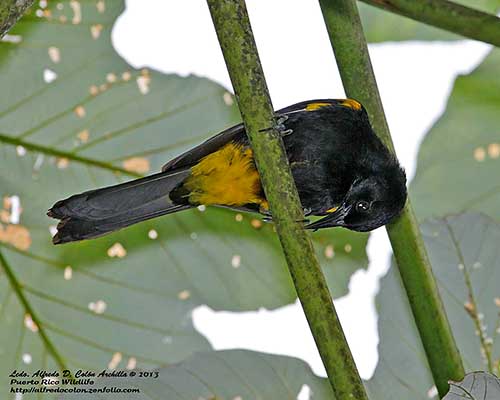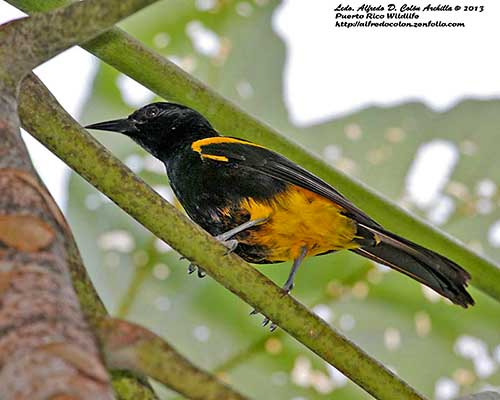
Fr: Oriole de Porto Rico
Ang: Puerto Rican Oriole
All: Puerto-Rico-Trupial
Esp: Turpial Puertorriqueño
Puerto Rico: Calandria
Nd: Puertoricaanse Troepiaal
Photographer:
Photos d'Alfredo Colón
Puerto Rico Wildlife
Text by Nicole Bouglouan
Sources:
HANDBOOK OF THE BIRDS OF THE WORLD Vol 16 by Josep del Hoyo- Andrew Elliot-David Christie – Lynx Edicions – ISBN: 9788496553781
NEW WORLD BLACKBIRDS – THE ICTERIDS by Alvaro Jaramillo and Peter Burke – Helm - ISBN : 0713643331
BirdLife International (BirdLife International)
Animal Diversity Web (University of Michigan Museum of Zoology)
Aves de Porto Rico – Sociedad Ornitológica Puertorriqueña
Neotropical Birds – Cornell Lab of Ornithology
Wikipedia, the free encyclopaedia
Puerto Rican Oriole
Icterus portoricensis
Passeriformes Order – Icteridae Family
INTRODUCTION:
The Puerto Rican Oriole was formerly a subspecies of Icterus dominicensis, but after recent studies, especially morphological and behavioural, it is now considered a full species, endemic to Puerto Rico.
DESCRIPTION OF THE BIRD:
Biometrics:
Length: 22 cm
Weight: M: 37-45 g – F: 34-39 g
The adult has mostly glossy black plumage with contrasting yellow lower back and rump, lower belly and thighs, and yellow lesser and median upperwing-coverts forming a conspicuous epaulet. Upper and undertail-coverts are black and tipped yellow.
The head is black. The stout, fairly long bill is blackish. The eyes are dark brown. Legs and feet are grey.
Male and female are similar.

The juvenile has olive-green upperparts with yellow rump, while the head shows reddish tinge, brighter than on the upperparts. The underparts are yellowish with rufous wash on breast. Chin and lores are often yellowish, but they can be black sometimes.
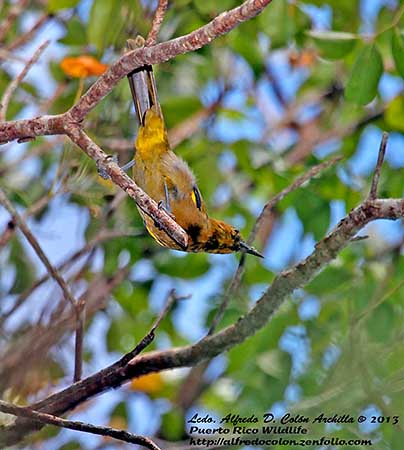
RANGE:
The Puerto Rican Oriole is endemic to Puerto Rico.
HABITAT:
The Puerto Rican Oriole frequents tropical and subtropical forests, mangroves and palm groves. It can be found in orchards, citrus groves and coffee plantations, and in parks and gardens.
This species occurs from sea-level up to 1000 metres of elevation.
CALLS AND SONGS: SOUNDS BY XENO-CANTO
The Puerto Rican Oriole’s call is a harsh “keek’ or “check”, and a single, musical “chup”.
The song is a high-pitched, mixed series of ascending and descending whistles, buzzes and warbles including between 15 and 27 different notes.
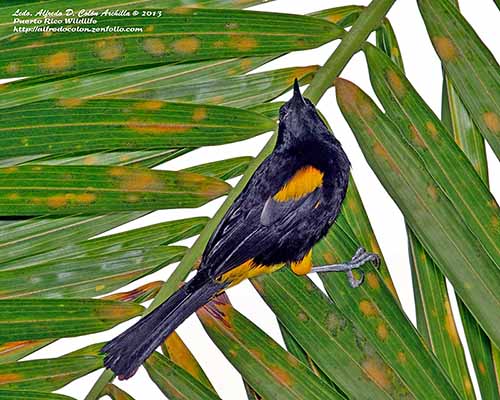
BEHAVIOUR IN THE WILD:
The Puerto Rican Oriole feeds primarily on insects and various small invertebrates including several insect species and spiders. Some small vertebrates such as lizards and frogs are occasionally caught. It also consumes seeds, nuts and fruits.
It is often seen in pairs or family groups after the reproduction, foraging in trees where they glean preys from leaves and epiphytes, usually in dense vegetation.
The Puerto Rican Oriole is generally monogamous, and mates have long-term pair-bonds. In the family Icteridae, the male usually displays from a perch. It moves head and body in order to expose the bright yellow patches. The head is lowered, the feathers are raised on the body, while wings and tail are opened and spread. These displays are accompanied by songs.
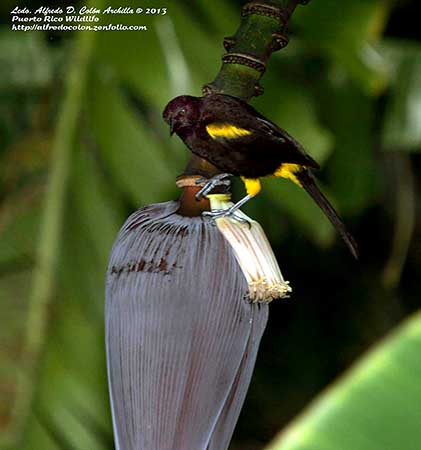
This species is resident in Puerto Rico.
The flight is direct and fast, with rapid wingbeats.
REPRODUCTION OF THIS SPECIES:
The breeding season takes place from February to July, but mainly between March and June. The Puerto Rican Oriole is a solitary nester.
The female builds the nest attached to the underside of palm frond, or other plant species such as Heliconia, or banana leaves. It can be placed up to 4 metres above the ground. Such nest varies in size and complexity, depending on each female and plant support.
It often resembles a hanging basket made with palm fibres woven together. The nest-chamber is sparsely lined with stems.
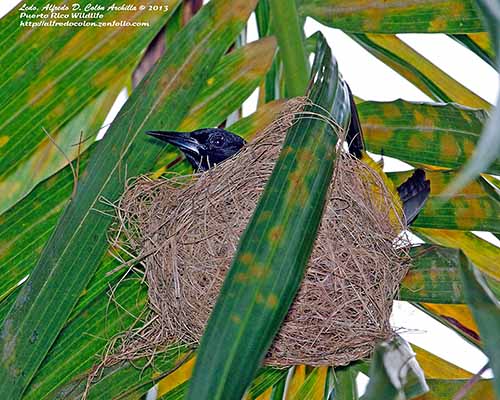
The female lays 2-3 white to bluish-white eggs with sparse grey and brown markings. The incubation is apparently by the female alone, but the male may feed her during this period of about 11-15 days.
The chicks are fed by both parents, and their diet often includes some fruits. They leave the nest two weeks after hatching.
During the nesting period, the male guards and defends the nest. They remain in family groups after the reproduction.
The Puerto Rican Oriole’s nests are often parasitized by the Shiny Cowbird, and more in coastal areas than inland. Only 14% of the host eggs produce fledglings in parasitized nests.
PROTECTION / THREATS / STATUS:
The Puerto Rican Oriole is common in Puerto Rico, and can be seen in several habitat types, including modified by humans. However, the population is suspected to be declining due to habitat destruction and fragmentation.
But currently, this species is evaluated as Least Concern.
